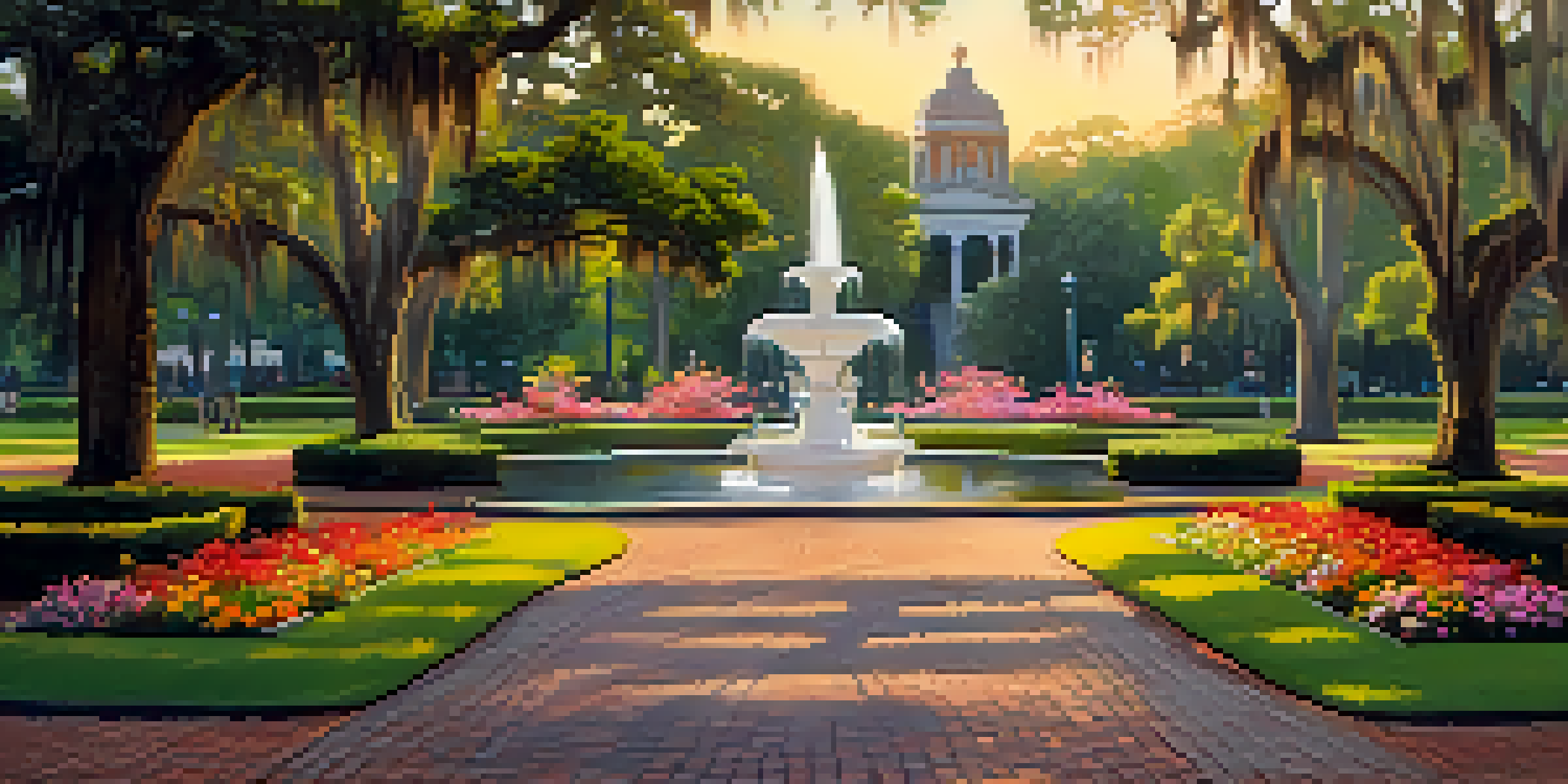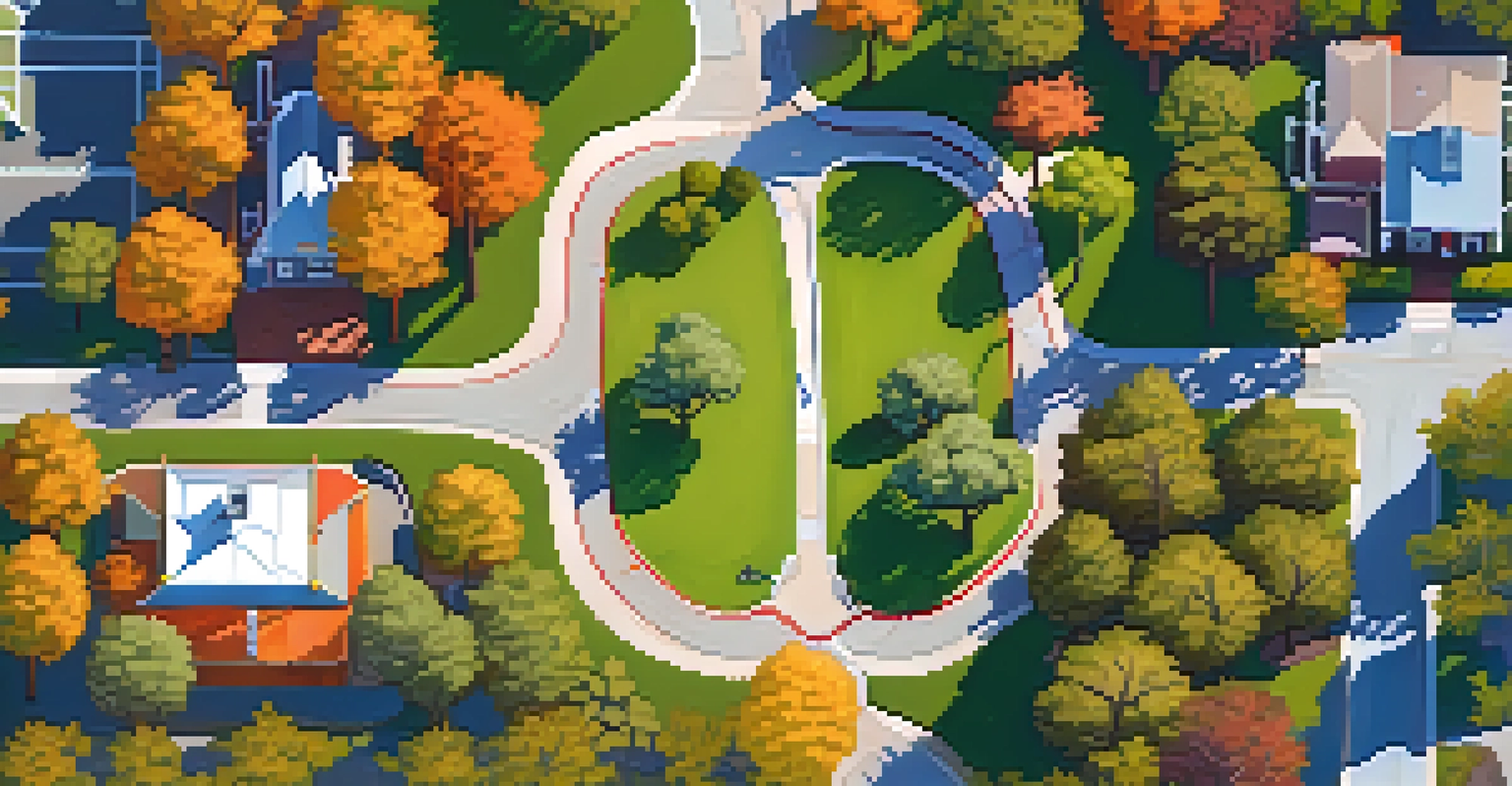The Role of Green Spaces in Savannah's Urban Environment

Introduction to Savannah's Green Spaces
Savannah, Georgia, is renowned for its stunning architecture and rich history, but its green spaces are equally important. These parks and gardens are not just beautiful; they play a crucial role in the city's ecosystem. From the iconic Forsyth Park to smaller neighborhood greens, these spaces provide a necessary breath of fresh air amid urban life.
Parks and green spaces are the lungs of our cities, providing vital air and a sense of community.
Green spaces in Savannah serve various purposes, including recreation, community gatherings, and environmental sustainability. They create a sense of place and belonging, inviting both residents and visitors to enjoy the outdoors. This blend of natural beauty and urban living contributes to the city's unique charm.
Additionally, Savannah's layout, featuring numerous squares and parks, encourages walkability and outdoor activities. These green areas are integral to the city's identity, providing a serene contrast to the bustling streets, making them essential for both physical and mental well-being.
Environmental Benefits of Urban Green Spaces
Green spaces are vital for maintaining a healthy urban environment. They help improve air quality by absorbing carbon dioxide and releasing oxygen, which is crucial in a city like Savannah where traffic and development can increase pollution levels. Trees and plants also act as natural filters, reducing dust and particulate matter.

Moreover, these areas promote biodiversity by providing habitats for various species. From birds to butterflies, the flora in Savannah's parks supports a thriving ecosystem, contributing to the overall health of the environment. This biodiversity is not just beautiful; it enhances ecological resilience against climate change.
Green Spaces Boost Urban Health
Savannah's parks promote physical activity and mental well-being, serving as essential areas for community health.
Additionally, green spaces play a role in managing stormwater runoff, which is particularly important in coastal cities prone to flooding. By absorbing rainwater, parks help reduce the risk of urban flooding, protecting homes and businesses while maintaining the aesthetic appeal of the city.
Social Impact of Green Spaces on Communities
Green spaces foster community interaction and social ties. Parks serve as gathering spots for families, friends, and neighbors, creating opportunities for socialization and community events. These interactions can strengthen community bonds, promoting a sense of belonging and collective identity.
The best thing about the parks is that they invite us to come together, to play and to breathe.
Events like farmers' markets, festivals, and outdoor movie nights held in parks create vibrant community cultures. They not only draw people together but also support local businesses and artisans. This engagement helps to create a lively atmosphere that enriches local culture and economy.
Moreover, accessible green spaces are essential for children’s development. They provide safe environments for play, encouraging physical activity and exploration. This interaction with nature is crucial for fostering creativity and cognitive development in young minds, highlighting the importance of these spaces.
Health Benefits Linked to Urban Green Spaces
The presence of green spaces in urban areas like Savannah significantly impacts public health. Studies show that regular access to parks and nature can reduce stress, anxiety, and depression. The calming effect of nature encourages physical activity, leading to healthier lifestyles.
Walking, jogging, or simply enjoying a picnic in a green space promotes cardiovascular health and overall well-being. Savannah's parks provide ample space for exercise, making it easier for residents to incorporate physical activity into their daily routines. This access is especially valuable in urban settings where space can be limited.
Historical Roots of Green Spaces
The city's green areas reflect Savannah's rich history and cultural heritage, designed to foster community interaction.
Additionally, the mental health benefits of spending time in green spaces are well-documented. Nature exposure has been linked to improved mood and cognitive function, serving as a natural remedy for the hustle and bustle of city life. Hence, the green spaces in Savannah are not just leisure areas; they are essential for fostering a healthier community.
Historical Significance of Savannah's Green Spaces
Savannah's green spaces are steeped in history, reflecting the city's rich cultural heritage. Established in the 18th century, many parks were designed to serve as social hubs and gathering places for residents. The layout of squares and parks was intentional, promoting a sense of community among the diverse population.
Historical figures, such as James Oglethorpe, emphasized the importance of green spaces in urban planning. These areas were not only practical but also symbolic, representing the city’s commitment to beauty and community well-being. Today, they continue to embody Savannah's historical narrative.
Preservation efforts for these historic parks are crucial, as they serve as reminders of the city’s past. By maintaining and enhancing these green spaces, Savannah honors its history while ensuring future generations can enjoy their benefits. This blend of history and nature makes Savannah's parks unique and significant.
Challenges Facing Savannah's Green Spaces
Despite their many benefits, Savannah's green spaces face several challenges. Urbanization and development pressures threaten these areas, often resulting in reduced green space availability. As the city expands, maintaining and protecting these vital resources becomes increasingly complex.
Environmental issues, such as climate change, also pose significant risks. Rising temperatures and unpredictable weather patterns can affect the health of trees and plants within these parks. It’s essential for city planners to consider climate resilience when designing and maintaining these green areas.
Challenges Threaten Green Areas
Urbanization and climate change pose significant risks to Savannah's green spaces, necessitating proactive community engagement and planning.
Community engagement is crucial in addressing these challenges. Encouraging residents to participate in the care and upkeep of green spaces can foster a sense of ownership. By working together, communities can ensure these spaces remain vibrant and accessible for everyone.
Future of Green Spaces in Savannah
Looking ahead, the future of Savannah's green spaces will depend on proactive planning and community involvement. There is an increasing recognition of the importance of these areas, leading to efforts focused on sustainability and enhancement. Innovative designs and eco-friendly practices are being integrated into urban planning.
Emerging trends, such as urban gardening and green roofs, are gaining traction in Savannah, providing additional opportunities for green space creation. These initiatives not only beautify the city but also promote environmental sustainability. As communities become more involved, creative solutions will likely emerge to address current challenges.

Ultimately, the preservation and expansion of green spaces will be vital for Savannah's future. By valuing these areas and recognizing their multifaceted benefits, the city can ensure that they continue to thrive, enhancing the quality of life for all residents.